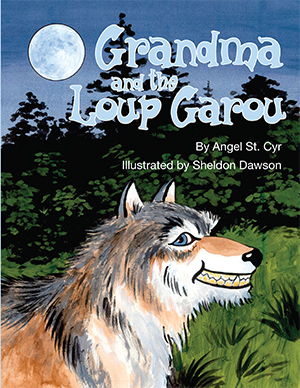| ________________
CM . . .
. Volume XXII Number 35. . . .May 13, 2016
excerpt:
Joseph, Katy, Jules are spending time with their grandparents on the farm. They look forward to coming to the farm where they help with the harvest and play outside. In particular, they enjoy listening to their grandparents tell stories around the campfire in the backyard. Their Grandma Elisabeth has a special story to tell them about their great, great uncle Louis Heibert. When Louis turned 12, he was allowed to go with his family on a hunt to stop the wolves from killing their animals. Unfortunately, he got lost and had to spend the night in the woods, only to have a very special wolf lead him home. Shortly after he arrived home, his cousin Baptiste arrived home as well. The next day, Louis found out that the wolf who led him home was his cousin Baptiste, and that the ability to turn into a wolf was something that had been in their family for generations. It is a choice that each individual who is told of the ability must make for themselves, but if they tell others, they lose the ability to transform. When Joseph asks their grandmother what choice Louis made, she asks him what he thinks. Later that night while Katy and Jules sleep soundly, Joseph sees a wolf that resembles his grandmother out his bedroom window. When he looks again, all he sees is the moonlight. This picture book provides an interesting take on werewolf folklore. Written in third person, the story provides a very approachable setting for children to hear of the loup garou within a family environment. As the loup garou in Grandma and the Loup Garou remains in control of his human mind and provides help to others rather than harm, most of the more fear inducing elements of werewolves are removed. Given that the subject of the book is a folklore being told around a campfire, the plot is not necessarily believable; however, the characters are very credible. The grandparents are eager to share their family secret with their grandchildren and leave them to make their own conclusions regarding the plausibility of the story. The children are torn between believing their grandmother and trying to make sense of what they previously believed to be impossible. The language and pace are both appropriate for the story. The grandmother’s story within the story is interrupted with questions by the siblings, which is a wonderful way for the audience to develop understanding of how the main characters are responding to the story - do they believe what they are being told is true? How is it possible for a person to be both man and wolf? If the transformation runs in their family, are there any loups garous in their family presently? Also, while the ages of Joseph, Katy, and Jules are not given, their questions are simple and use easy-to-understand vocabulary appropriate for children. Sheldon Dawson provides full-page illustrations that represent scenes from the story. While the images that portray the siblings and their grandparents are bright and colourful, the images that represent scenes from Grandma Elisabeth’s story are dimly coloured, similar in effect to a photograph from former generations. This illustration style is appropriate as her story is supposed to be based on an old family secret, and the appearance of the illustrations, as if they were drawn from an old memory, sustains that effect. Recommended. Meredith Harrison-Lim is a MLIS graduate who works for the Federal Government in the National Capital Region.
To comment on this title or this review, send mail to cm@umanitoba.ca.
Copyright © the Manitoba Library Association. Reproduction for personal use is permitted only if this copyright notice is maintained. Any
other reproduction is prohibited without permission.
CM Home |
Next Review |
Table of Contents for This Issue -May 13, 2016
| Back Issues | Search | CM Archive
| Profiles Archive |
